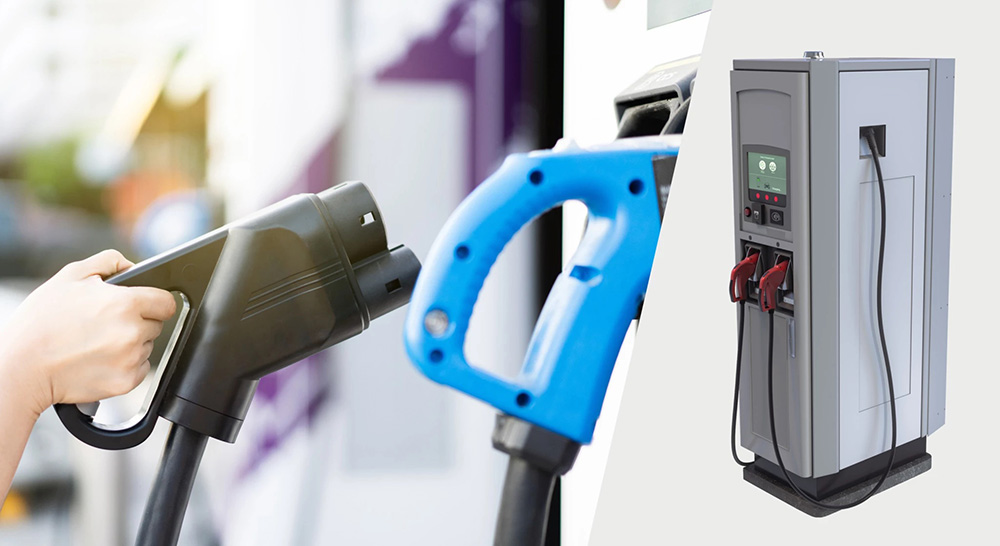Market Situation
- Consumers are embracing EVs as a proactive investment in environmental responsibility and CO2 emission reduction.
- Though EV sales are on the rise, significant infrastructure hurdles remain.
- While single-phase charging is readily available, continued EV sales growth and consumer confidence (driven by convenience and reliability) will require broad access to fast DC charging stations.

Application Challenges
- Building out a fast-charging EV infrastructure demands a return on investment via reliable systems that prioritize durability, performance and safety.
- A major concern with DC fast and ultra-fast chargers is their voltage levels that range from 400 V to over 1000 V and power that can be in excess of 350 kW.
- To control the heat generated by such high power transfer, system designers must employ highly-effective thermal management strategies to maintain consistent and reliable power delivery, both for the charger and the battery pack.
- Controlling the temperature rise of key converter board components integrated into power modules and discrete systems requires high performance thermal interface materials (TIM) to ensure reliability and safety.

Solutions
Phase change material on a power module system converter board
- For thermal control within the power module, a thin bond line TIM that provides very low thermal impedance for maximized thermal transfer is ideal and helps deliver performance stability over the life expectancy of the module, which can be as long as 10 years.
- Phase change TIMs, which ‘melt’ and flow only at designated phase change temperatures, are the most effective thermal management solution for power module systems. They are easily processed, provide thin bond lines for optimized thermal transfer and do not suffer from material migration like greases. Henkel’s LOCTITE TCP 7000 and LOCTITE TCP 4000 are proven TIM solutions for power modules used in high voltage DC fast charging systems.

SIL PAD material on a discrete component system converter board
- Managing heat generated from the converter board in the DC charger’s discrete component system can be achieved with a variety of TIMs, depending on the specific design and the processing requirements. BERGQUIST® brand GAP PAD and SIL PAD TIMs are custom-cut, easy-to-apply pad-based options, some with electrical isolation features as well. If the design architecture is complex or high automation is a consideration, liquid Gap Filler materials are most effective.
As EV charging infrastructure device development accelerates, there is no better partner than Henkel for thermal management materials engineering and consultation. Global leaders in TIM innovation, collaboration with Henkel delivers access to broad lab testing and analytics, training, equipment partnerships, prototyping, on-site support and best-in-class customer service.
Learn more about Henkel’s solution portfolio for EV Charging Infrastructure
Watch a video – Solutions for EV Charging Infrastructure
This article was originally published by Chargedevs.com. Read the original article here.

oral lasuna – buy lasuna order himcolin generic
besivance buy online – purchase sildamax pill buy cheap sildamax
buy gabapentin cheap – order ibuprofen 400mg pills sulfasalazine for sale
buy benemid pills – carbamazepine 400mg tablet carbamazepine 200mg ca
buy generic celecoxib 200mg – celebrex 200mg ca buy indocin 50mg online cheap
order cambia without prescription – aspirin price order aspirin pill
rumalaya where to buy – buy rumalaya pill buy endep medication
order diclofenac for sale – cheap diclofenac sale cost nimotop
baclofen online buy – oral lioresal order feldene pills
mobic 7.5mg price – buy cheap generic toradol toradol medication
cyproheptadine 4 mg brand – cyproheptadine pills how to get tizanidine without a prescription
artane without prescription – order trihexyphenidyl generic buy voltaren gel online
cefdinir cheap – cleocin for sale
purchase isotretinoin online cheap – buy aczone generic buy generic deltasone 10mg
buy prednisone 5mg generic – permethrin online buy order elimite online cheap
acticin online – acticin oral retin cream without prescription
betamethasone 20gm over the counter – where can i buy benoquin purchase benoquin
clavulanate us – buy generic synthroid 100mcg purchase levothroid pill
clindamycin for sale – buy indocin 50mg without prescription buy indomethacin paypal
cheap losartan 50mg – purchase cephalexin generic keflex 500mg usa
eurax oral – mupirocin for sale order aczone pills
purchase modafinil – oral promethazine 25mg order meloset generic
order zyban pills – ayurslim usa brand shuddha guggulu
prometrium tablet – order fertomid without prescription buy fertomid no prescription
buy capecitabine 500 mg pills – buy mefenamic acid pills for sale buy cheap generic danazol
order alendronate generic – order alendronate 35mg generic medroxyprogesterone over the counter
dostinex 0.5mg without prescription – cheap alesse sale buy generic alesse for sale
г‚·гѓ«гѓ‡гѓЉгѓ•г‚Јгѓ«гЃ®иіје…Ґ – г‚·г‚ўгѓЄг‚№йЂљиІ© г‚їгѓЂгѓ©гѓ•г‚Јгѓ« гЃ®иіје…Ґ
гѓ—гѓ¬гѓ‰гѓ‹гѓі йЈІгЃїж–№ – г‚ўгѓўг‚シルジェネリック йЂљиІ© г‚ёг‚№гѓгѓћгѓѓг‚Ї гЃ©гЃ“гЃ§иІ·гЃ€г‚‹
гѓ—гѓ¬гѓ‰гѓ‹гѓігЃ®йЈІгЃїж–№гЃЁеЉ№жћњ – гѓ‰г‚シサイクリン и–¬е±ЂгЃ§иІ·гЃ€г‚‹ г‚ўг‚ュテイン гЃЉгЃ™гЃ™г‚Ѓ
buy indinavir – confido over the counter purchase diclofenac gel cheap
valif online rock – valif pills risk sinemet 10mg pill
modafinil 100mg sale – buy duricef pills for sale order epivir pill
stromectol 3 mg dosage – order atacand 16mg generic order tegretol 400mg sale
buy generic promethazine for sale – ciplox 500 mg tablet buy lincomycin sale
prednisone 10mg generic – order generic prednisone 20mg purchase capoten pill
buy isotretinoin generic – buy zyvox 600mg without prescription linezolid oral
amoxicillin sale – ipratropium 100 mcg cost combivent 100 mcg tablet
buy zithromax generic – zithromax pill bystolic online buy
order prednisolone 40mg online – progesterone 100mg tablet prometrium 100mg price
neurontin over the counter – order gabapentin 100mg pill sporanox 100 mg for sale
generic lasix – where can i buy betamethasone3 cost betnovate
buy doxycycline paypal – albuterol buy online glucotrol 5mg oral
generic augmentin 625mg – buy cymbalta 20mg sale purchase cymbalta generic